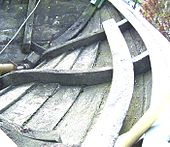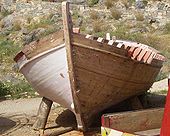planking
The planking is a covering or cladding or cladding made of planks , planks or panel materials that are applied to a supporting structure below. The planking often forms the outer shell of an object or a skeleton structure.
In construction , planking with a decorative function in interiors is also referred to as paneling or, more generally, formwork . Also, wood material -, fiber or plasterboard referred to as cladding, in the drywall to the underlying structure (eg. Upright and bolt ) to be attached.
In the body shop, outer skin parts are called planking.
In wooden shipbuilding, the shell made of planks , which is built on the skeleton of keel and frames and together with this results in the ship's hull, is called planking.
shipbuilding
In shipbuilding there are two different methods of applying the planking to the skeleton. In early Northern European shipbuilding, clinker construction prevailed (e.g. long Viking ships), before it was first developed in the late Middle Ages by composite ship types with a hull below the waterline, but above it with clinker hulls ( cogs , holks ), then, however, by ships that were completely constructed in krawn construction ( Kraweel ), which had been predominant in the Mediterranean region since ancient times.
Clinker construction
In the clinker construction, the planks are not attached edge to edge, but overlapping. The upper plank overlaps the lower plank (see illustration). The area of overlap is called the landing. Here, the lower plank has to be snuggled (planed at an angle) in order to achieve a good connection between the planks and water tightness. To ensure tightness, u. U. inserted a cotton thread between the planks. The planks are riveted together. Either curved frames or fixed frames are used as frames, in which there must be a corresponding step-shaped recess for each plank.
Due to the warping of the wood, the planks shift slightly against each other without opening a joint. As a result, after a long period of being dry, the boats are tight again quicker than boats with crawlers. That is why dinghies and lifeboats in particular were built in this way, but also yachts such as the folk boat , the longships of the Vikings and early Hanseatic cogs . In plastic construction, too, the surface of clinker planks is sometimes reproduced, the stepped ribs stiffening and deadening the comparatively thin plastic skin.
From a hydrodynamic point of view , clinker construction is interesting. Due to the fore and aft edges that form the overlapping planks, an increased degree of lateral guidance is achieved. This contributed to the fact that Viking ships sailed quite well and were even able to cruise to a limited extent in spite of the fact that they were sailed with a yard , as experiments with replicas have shown.
A further development is the "smooth clinker construction", in which the overlapping parts of the planks are processed in such a way that they interlock and thus lie in one plane. The planking is then smooth inside and out and mechanically connected to one another over its full length. This design achieves an almost complete tightness and very high strength of the hull. However, the technology is technically very complex, so that it never caught on on a large scale.
Kraweel construction
With the Kraweel or Karweel construction ( Middle Low German from Portuguese Caravela (German: Karavelle) ) the planks are attached edge to edge (see illustration). This gives the hull a smooth surface. If the planks are too short to reach the entire length of the ship, bumps occur. These must be as far apart as possible so as not to weaken the structure of the trunk. In order to be able to cover the curve of the trunk evenly, the planks are tapered at the front and back. A kraweelgeplanktes boat waterproof to make, it must be caulked be. Since the seams between the planks enlarge when working with the wood, boats with crankshafts are more likely to leak than those made of clinker construction.
The Kraweel construction ultimately prevailed over the clinker construction (see above) for large ships, as the load-bearing capacity of the overall construction is higher with a Kraweel planking. The forces are transmitted here via the seam edges and not only via the tenons, rivets or nails as in the clinker construction method. This allows greater torsional forces to be absorbed and distributed evenly over the structure. In addition, the smoother surface also speeds up the speed and makes cleaning and maintenance easier. The smooth clinker construction would be superior in terms of strength and tightness, but it is considerably more complex to manufacture.
The Kraweel construction comes from the Mediterranean area and was already used by the ancient Egyptians and has been preserved in the Mediterranean area throughout antiquity . At the end of the Middle Ages , the Portuguese caravel was the best-known type of ship in this construction and gave the construction its name in the German-speaking area. It came to Northern Europe through trade relations with the Hanseatic League and was initially used for cogs in the area of the ship's floor. Well-known caravels were the escort ships of Christopher Columbus and the Peter von Danzig (around 1470). Ships with Kraweelbeplankung were also known as Kraweel , Kraweelschiff or Karweelschiff .
Already in China of the Song dynasty (960–1279 AD) ships were planked with several layers of kraweels laid one on top of the other, some at an angle to one another (diagonal kraweel). As a result, leakage problems were practically completely eliminated and extreme torsional rigidity was achieved with a low material thickness . After the Second World War , the German example were speedboats the Jaguar class built in this manner. After the development of suitable adhesives (especially epoxy resins ), the form-glued construction emerged, in which several layers of veneer are glued together crosswise on a form.
Aircraft construction
In aircraft construction, many terms have been adopted from shipbuilding. As a cladding , a coating of the basic structure will be understood by plate material too. However, after the initial aircraft plywood, aluminum sheet is mostly used here.
In wooden aircraft construction, the connection of the individual plywood elements is achieved by mutually sloping the contact surfaces ( shafts ), which increase the adhesive surface and avoid abutting edges. The clinker construction was only adapted once in aviation and that was for the fuselage of the LVG Roland D.VI fighter aircraft from 1918.
If the entire surface is executed in this way, one speaks of full planking , if it is only parts of partial planking . Here, the parts of the outer skin that are still open are usually supplemented by a fabric covering . The introduction of a partially clad wing made the wing torsionally stiff and enabled better profile accuracy. In this way, the wings could be designed to be self-supporting, i.e. without struts and tension cables (e.g. Fokker D.VIII ).
The planked front area of a wing is called the torsion nose (D-box). In modern plastic aircraft construction one no longer speaks of planking, but of the shell (shell construction).
Individual evidence
- ↑ Alfred Dudszus, Alfred Köpcke: The great book of ship types. Weltbild, Augsburg 1995, pages 165-167.





